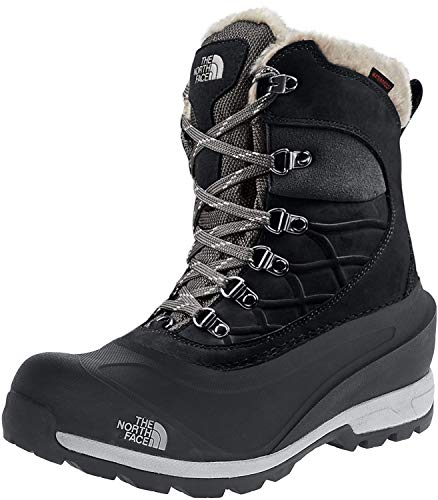Best Women’s Hiking Boots (Reviews) for Alaska
They don’t call Alaska the Last Frontier for nothing, and there are unique challenges that it throws at you, no matter when you’re visiting.
Whether you go in the summer or winter, you need waterproof hiking boots for a lovely experience. If lightweight and breathable waterproof boots make the right choice in the summer, you should look for insulated and waterproof boots for your winter hikes.
Top Women’s Hiking Boots for Alaska
1. Arc’teryx Acrux TR GTX Boot Women’s
Hikers looking for boots for all-year-round use in Alaska can take the plunge with the Arc’teryx Acrux TR GTX Boot Women’s.

See reviews and pricing on Amazon
The boots are reliable, comfortable, rugged, and lightweight. They take very well multi-day hikes and even backpacking on rough trails. They’re made with waterproof material, blocking wet elements from getting inside the boots.
The TPU chassis at the midfoot and forefoot offers torsional rigidity and stability, whereas the molded rubber toe protects against stone bruising. The EVA midsole is injected for padded support, and the 4mm thick OrthoLite 3D molded inserts reduce shock from hiking for superior comfort.
The padded tongue and collar create soft support for the ankle and the boots, which take use all year long. Some may feel that the price is a tad high, but the shoes are worth every single penny.
You won’t have to worry about your feet getting cold when hiking in the snow in Alaska with the
2. The North Face Women’s Chilkat 400
The North Face Women’s Chilkat 400. Even if they’re taller than typical hiking boots, the boots are comfortable and great for hiking.

See reviews and pricing on Amazon
The footwear is made with full-grain leather (it’s BLC compliant), which is naturally waterproof. The build of the boots makes them ideal for winter hiking as they’re seam sealed. The waterproof body will block the elements for dry feet at all times. The shoes also come with injection-molded and anatomical waterproof TPR shell, so protection against the snow is superior.
The lace-up closure provides the best fit, whereas the rustproof hardware ensures durability. The boots feature D-ring that is gaiter-compatible and heel pull loop for more comfortable use. The faux fur collar has a soft touch feel and improves the boots’ aesthetics, whereas the 400g PrimaLoft Silver insulation keeps the feet warm. The dual-density Northotic 2.0 footbed has forefoot padding and soft heel for better shock absorbency. In contrast, the rigid TNF Winter Grip outsole has IcePick lugs (temperature-sensitive) for superior traction in the snow. The breathability could be better, but that’s a minor flaw compared to the boots’ overall value.
3. Vasque Women’s Breeze Lt Low GTX Gore-tex Waterproof Breathable Hiking Shoe
For your summer hikes in Alaska, a lightweight and waterproof pair of hiking shoes is ideal. Please take a look at the Vasque Women’s Breeze Lt Low GTX Gore-tex Waterproof Breathable Hiking Shoes since they’re both waterproof and reliable for hiking.

See reviews and pricing on Amazon
The boots are made with synthetic microfiber with abrasion-resistant mesh for better ventilation and less weight. The upper body works excellent with the Lite Gore-Tex that blocks water from inside while allowing moisture escape.
The dual-density compression-molded EVA midsole (EnduraLast) absorbs shock and provides soft support, while the padded tongue and collar ensure soft support for the ankle. The lace-up system helps you get the snug fit you need for more stability inside, and the Vibram Mega grip provides grip and traction on slippery, rocky, dry, and wet trails. The boots run a tad small, but they’re an excellent buy for summer hikes in Alaska on any given day.
How should you select your hiking boots for Alaska?
Alaska is a fantastic destination for those of you who dear and don’t hold back from challenges and adventures in the summer and winter. However, going with the proper hiking equipment will make the difference as you want your experiences to be also rewarding, not only challenging.
Here are the fundamental aspects to consider in your hiking boots when preparing for hiking in Alaska:
Waterproofness
No matter if you go in the summer or the winter, you need your hiking footwear to be waterproof. Several technologies are used for waterproofness, but Gore-Tex is the most popular. Reputed footwear companies developed proprietary methods for making the boots waterproof, with KeenDry from Keen as a great example.
Even if water getting inside is solved with waterproofness, your boots should also be breathable. With proper ventilation, moisture doesn’t build up inside the shoes, so your feet stay dry the whole time. All in all, it’s more accurate to say that your hiking boots for Alaska should be both waterproof and breathable, all year round.
Insulation for the winter/breathability for the summer
Winters in Alaska can get very cold, so you want your boots also to keep your feet warm, not only dry. No matter how great your shoes are at blocking water, it would help if you still had them come with insulation to provide warmth wear.
400g of insulation will be enough most of the time, as you don’t want to lose the comfort. More insulation means heavier boots, which may slow you down while hiking. You can always add some woolen socks for more warmth, anyway.
If you hike in the summer, your boots should be highly breathable so that your feet don’t get toasty. As a matter of fact, breathability is essential, no matter when you’re hiking. Poor ventilation inside the boots makes the sweat build-up, decreasing your comfort, and causing blistering.
Support& stability
No matter where you’re hiking on this planet, you will need support while hiking. Hiking is a strenuous activity, which puts a lot of pressure on your feet, and you need stability both inside and outside the boots.
A wider build in the toe area gives better stability in the front (and toes aren’t cramped), but the heel cup should keep the heel in place. Stability shank inside, a molded EVA midsole will provide better and soft support, whereas a padded collar and tongue will support the ankle.
As hiking in Alaska means you will deal with various surfaces, you need grip and stability. Look for hiking boots with grippy outsole (Vibram is rigid and flexible enough) and slip-resistance build. Self-cleaning lugs are also great, speeding you while hiking. Boots with mudguards will also provide better grip and traction on the various trails in Alaska.
FAQs
Q: Can you use mesh hiking boots in Alaska?
A: Even if the mesh is highly breathable and you want breathable hiking boots, it doesn’t make the best choice when hiking in Alaska. The trails are still rugged and challenging, and the mesh should be resistant to wear and tear if you don’t wake up with broken boots in the middle of your hike.
Boots made with suede or nubuck leather with mesh inserts are more breathable than full-grain leather boots, but they may not take the intense wear as full-grain leather models will.
Q: Should you buy full-grain leather hiking boots for Alaska?
A: Full-grain leather boots are an essential buy, as they’re long-lasting and expensive choice. However, full-grain leather boots are more massive than boots made with mesh, suede, nubuck, or synthetic leather.
If you’re planning multi-day hiking, the full-grain leather boots may be too heavy for comfortable hiking. Look for models similar in terms of waterproofness, ruggedness, and reliability as full-grain leather models, but lighter.
Q: Will trail running shoes work for hiking in Alaska?
A: should your trails be well-maintained, flat, or paved, some good trail running shoes will work when hiking in Alaska. However, if your hike will involve several creek crossings, muddy tracks, or scree, you will need ankle support and waterproof build for the best performance. You may very well begin your hike with some trail running shoes and pack a reliable pair of hiking boots for the more challenging segments of your trek.
Q: Do you always need to break-in your hiking boots?
A: Ideally, you don’t need to break in your hiking boots, no matter if you go to Alaska or not. It’s mostly full-grain leather boots that need a break in as full-grain leather may be stiffer than other materials.
However, full-grain leather gets softer with each wear and will conform to your foot’s unique shape like no other material. Boots made with suede, nubuck, and mesh may feel softer out of the box, but they could still cause blistering.
Play it on the safe side and always break in your hiking boots before heading to your destination. Perfectly looking boots are useless if they cause blistering, making hiking painful.


